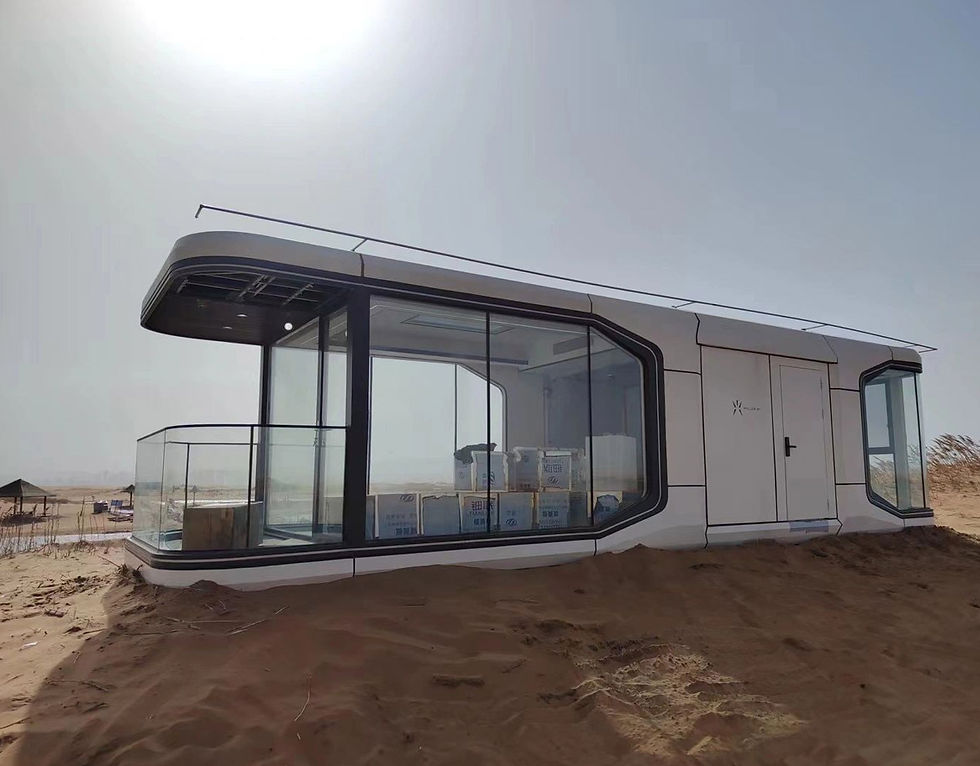Tiny Smart House – The Future of Compact, Connected Living
- Blogger
- Sep 12
- 3 min read
A tiny smart house brings together two of the biggest lifestyle trends of our time: tiny living and smart technology. By combining minimalistic, compact home designs with cutting-edge automation, these houses deliver maximum functionality in minimal square footage. They’re eco-friendly, affordable, and ideal for people who want to simplify their lives without giving up modern comforts.
In this in-depth guide, we’ll explore everything about tiny smart houses from their features, design ideas, and costs to their benefits and future potential.

What Is a Tiny Smart House?
Definition
It is a compact home (usually under 600 sq ft) that integrates smart home technology—like automated lighting, climate control, voice assistants, energy-saving appliances, and security systems.
Core Idea
Live small, live smart.
Maximize efficiency through design and technology.
Reduce waste and energy consumption while maintaining comfort.
Benefits:
Space Efficiency
Multi-purpose furniture and storage solutions.
Smart layouts that make a small area feel spacious.
Voice-activated controls save time and effort.
Cost Savings
Lower construction costs compared to traditional homes.
Reduced electricity and water bills due to automation.
Smaller mortgage or no mortgage at all.
Environmental Impact
Energy-efficient appliances.
Solar integration for off-grid living.
Smart thermostats reduce unnecessary energy use.
Lifestyle Advantages
Minimalist living with high-tech convenience.
Easy to manage and maintain.
Freedom to live sustainably without sacrificing comfort.
Features:
Smart Living Room
Voice-controlled lighting and entertainment systems.
Convertible furniture (sofa-beds, foldable tables).
Smart window blinds and climate control.
Intelligent Kitchen
Compact, energy-efficient appliances.
Smart refrigerators with inventory tracking.
Touchless faucets for water conservation.
Automated Bathroom
Low-flow smart toilets and showers.
Heated mirrors and anti-fog features.
Leak detection sensors.
Connected Bedroom
App-controlled lighting and blinds.
Smart beds with sleep tracking.
Built-in wardrobes with organization sensors.
Security & Safety
Smart locks with biometric access.
Motion-detecting cameras.
Smoke, fire, and CO2 smart alarms.
Approximate Cost:
Type | Cost Estimate (USD) |
DIY Smart Tiny House | $40,000 – $70,000 |
Prefabricated Smart Models | $70,000 – $120,000 |
Luxury Tiny Smart Houses | $120,000 – $250,000 |
Off-Grid Smart Units | $90,000 – $160,000 |
Note: Costs vary depending on location, smart system integration, and customization.
Design Ideas:
Minimalist Smart Homes
Simple, elegant designs focusing on function and efficiency.
Two-Story Smart Layouts
Vertical designs maximize space with smart stairs and lofts.
Container-Based Smart Houses
Eco-friendly homes repurposed from shipping containers, integrated with automation.
Luxury Smart Pods
Compact yet premium designs with high-end smart gadgets.
People Also Ask
Q1: Can it be off-grid? Yes, with solar panels, water collection systems, and batteries, they can function independently.
Q2: Are smart systems difficult to maintain? Not at all—modern devices are designed to update automatically and work seamlessly.
Q3: Do smart houses need Wi-Fi? Yes, most smart devices need internet for full functionality, but many work offline with Bluetooth.
Q4: How long does it take to build one? Prefab models can be ready in 2–6 months, while custom smart builds may take 6–12 months.
Knowledge Panel:
Definition: A compact home equipped with smart technology for efficiency, sustainability, and comfort. Features: Smart lighting, appliances, security, and climate control. Sizes: Typically 150–600 sq ft. Cost Range: $40,000 – $250,000. Benefits: Affordable, eco-friendly, modern, and energy-efficient. Use Cases: Full-time residences, vacation homes, rentals, or mobile living.
Benefits of Choosing:
Lower living costs.
Eco-friendly lifestyle.
Easy integration with renewable energy.
Modern conveniences in a small space.
Ideal for singles, couples, and small families.
Excellent for Airbnb or vacation rental business.
Decorating:
Living Room Tips
Use foldable and multipurpose furniture.
Install large windows for natural light.
Add a projector instead of a TV to save space.
Kitchen Tips
Vertical storage racks.
Smart induction cooktops.
Pull-out pantry designs.
Bedroom Tips
Loft-style sleeping with storage underneath.
Automated blackout blinds for better sleep.
Space-saving Murphy beds.
Future:
As technology advances, in smart houses are expected to:
Integrate AI-powered personal assistants.
Use predictive energy management systems.
Offer modular expansions with plug-and-play smart features.
Become more affordable as smart tech costs decline.
Final Thoughts
A tiny smart house proves that small can be mighty. With the right design and smart technology, it’s possible to enjoy luxury, comfort, and sustainability in just a few hundred square feet. Whether you want to live off-grid, reduce your carbon footprint, or simply enjoy a more minimalist lifestyle, a smart house is the future of modern living.



Comments